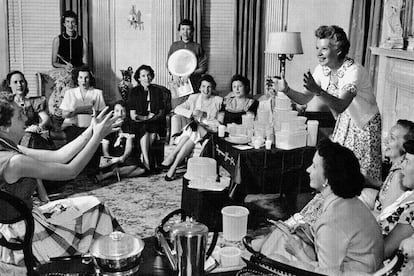The duo who drove Tupperware: A story of success, rivalry and bankruptcy
Earl Tupper created the containers that wound up being known by his last name — but it was Brownie Wise who made them popular

The story of Tupperware has all the ingredients for the script of a movie or a miniseries, save for a happy ending. There’s a male lead who achieves the American dream of running a successful business after various false starts, a woman who winds up paying for her own success, a professional rivalry, a product that became iconic and a bankruptcy, which it nearly escaped at the last minute, but to no avail.
It all began with Earl Tupper, born in 1907 in Berlin, a city in New Hampshire. Young Tupper grew up with his family on different farms in the neighboring state of Massachusetts, and began selling their harvests, door to door, at the tender age of 10. He was a dreamer who aspired to make history with his inventions and even compared himself with Leonardo da Vinci. In his diary, he would write of all the factors he had in common with the Italian genius: both started out poor, with notebooks full of sketches and countless ideas for new creations. These included the Tupper bomb (whose lethal force was due to carbon dioxide); a dagger-shaped comb that attached to one’s pants; and an instrument with which to remove the appendix through the anus. None were successful, as Alison Clark recounts in her book Tupperware: The Promise of Plastic in 1950s America. Nor did he triumph with his early gardening business, which eventually went bankrupt.
But thanks to that failure, at the end of the 1930s, he began to work at a plastic factory. Quickly, he realized the potential of said material, bought the necessary machinery and founded his own business, Tupper Plastics. Using polyethylene, he made gas masks for World War II, in addition to bowls and containers with airtight lids. Tupperware was born.
His products garnered praise in the media for their design and functionality, but sales were not forthcoming. Tupper was convinced that if he could demonstrate the virtues of his wares to the public, they’d end up buying them — but he couldn’t figure out how to make that happen.
It is at this point that another major player in the Tupperware story enters the narrative. Brownie Wise was a woman born in Georgia in 1913 who was, at the time, divorced with one child and living in Detroit. To earn the money she needed to care for her child, Wise had started to work as a salesperson of domestic items from the brand Stanley Home Products. She organized house parties to which she invited other women and showed off the merchandise.
When at the end of the 1940s, she encountered Tupper’s products, she decided to sell them the same way. Little by little, she began recruiting other women to follow her lead, and eventually, more products were being sold this way than in stores. Aware of Wise’s success and her great eye for business, Tupper hired her at the beginning of the 1950s and named her vice-president of marketing in order to develop a new division of the company that focused on house parties. At the decade’s midway point, there were around 20,000 people — the vast majority of them women — in the company’s network of salespeople. The parties became a mainstay in residential neighborhoods around the United States, with housewives amusing themselves via different games: from wearing hats made of domestic products to tossing around a Tupperware container full of grape juice to demonstrate its strength.
Wise decided to make Florida into the company’s sales headquarters. There, typically dressed in the shade of pink that wound up becoming her trademark, she welcomed Tupperware enthusiasts, doled out prizes to top sellers and held their annual meeting. Meanwhile, Tupper stayed in Massachusetts, doing research to develop and create new products at the company’s factory.
Wise — who was fun to be around and developed close relationships with the press and consumers, in contrast to Tupper’s more reserved nature — became so popular that she became the first woman to be featured on the cover of Business Week, in 1954. She was now the face of the company. The constant attention paid to Wise and the incentives she gave to sellers exasperated Tupper, and their relationship became so difficult, she was fired in 1958. Though she sued the company, she only managed to get a $30,000 severance package, equivalent to what had been her yearly salary. Soon after, Tupper sold the company for $16 million, got divorced and retired to Costa Rica, where he died in 1983.
Wise, for her part, co-founded three home delivery makeup companies, was president of Viviane Woodard Cosmetics, consulted for various firms and even entered into the real estate industry. She never managed to repeat the success she’d found with Tupperware. She died in Florida in 1992.
In the following decades, there were less and less house parties, the competition got fiercer and consumers began to choose cheaper products they could find in stories or with a few clicks from the comfort of their homes. The company that had given its name to the containers became blurry in consumers’ minds. And this was reflected in the company’s finances.
The pandemic gave new life to the firm, with more people cooking and eating at home and even hosting online Tupperware parties. But the subsequent return to normality caused sales to fall yet again. There was another hopeful moment in August 2023, when Tupperware memes went viral, spurring sales and shooting up the price of shares by 715% in just eight days, despite it having been at the brink of bankruptcy. But that respite was brief, and its stock price soon fell once again.
The situation since has done little but worsen since, and last week, the company looked to declare bankruptcy. The golden era of Tupper and Wise is long gone.
The downfall of a universal brand
Until just a few days ago, Tupperware was a brand of containers recognized throughout the world, even if it was on the decline. Its brand was so ubiquitous as to be nearly generic, synonymous with refrigerator storage and present in languages spoken around the globe. But the bankruptcy and the stock’s collapse brought it to the brink. In such a volatile environment, the company was valued at just $3 million. That’s a far cry from its 2013 high, when stocks topped $90 a piece and the firm reached a total value of more than $4 billion.
Sign up for our weekly newsletter to get more English-language news coverage from EL PAÍS USA Edition
Tu suscripción se está usando en otro dispositivo
¿Quieres añadir otro usuario a tu suscripción?
Si continúas leyendo en este dispositivo, no se podrá leer en el otro.
FlechaTu suscripción se está usando en otro dispositivo y solo puedes acceder a EL PAÍS desde un dispositivo a la vez.
Si quieres compartir tu cuenta, cambia tu suscripción a la modalidad Premium, así podrás añadir otro usuario. Cada uno accederá con su propia cuenta de email, lo que os permitirá personalizar vuestra experiencia en EL PAÍS.
¿Tienes una suscripción de empresa? Accede aquí para contratar más cuentas.
En el caso de no saber quién está usando tu cuenta, te recomendamos cambiar tu contraseña aquí.
Si decides continuar compartiendo tu cuenta, este mensaje se mostrará en tu dispositivo y en el de la otra persona que está usando tu cuenta de forma indefinida, afectando a tu experiencia de lectura. Puedes consultar aquí los términos y condiciones de la suscripción digital.
More information
Archived In
Últimas noticias
Petro claims the ELN was the target of US attack in Venezuela
Maduro counterattacks Trump with rhetoric and announces downing of nine drug trafficking aircraft
‘Ecce Homo’: The miraculous disaster that made a small Spanish town famous
Return to sex testing at the Olympics: IOC edges closer to banning transgender women
Most viewed
- Sinaloa Cartel war is taking its toll on Los Chapitos
- Oona Chaplin: ‘I told James Cameron that I was living in a treehouse and starting a permaculture project with a friend’
- Reinhard Genzel, Nobel laureate in physics: ‘One-minute videos will never give you the truth’
- Why the price of coffee has skyrocketed: from Brazilian plantations to specialty coffee houses
- Silver prices are going crazy: This is what’s fueling the rally











































